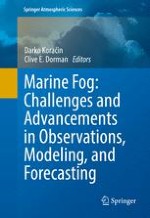Abstract
All problems inherent to models’ imperfection and generally insufficient vertical and horizontal resolution, as well as inability to obtain full and accurate initial and boundary conditions, amplify for fog predictions. This is due to a huge span of relevant parameters and processes ranging from aerosols to hemispheric synoptic conditions. Understanding fog characteristics and evolution as well as constructing accurate initial and boundary conditions for forecasting is severely hindered by absence of dense routine and also special measurements over the vast oceans. Fog modeling and forecasting has a long history from early methods based on persistence and synoptic indicators and later through weather analysis to contemporary methods using high-resolution numerical models on regional scales, mesoscales, and microscales. The main issues that are critical to understanding and forecasting marine fog include synoptic conditions and advection, local circulations and flow properties, turbulence, characteristics of inversion and subsidence, longwave and shortwave radiative fluxes, air-sea interaction, aerosols, microphysics, and coastal topography. The two main approaches to fog predictions are statistical and dynamical forecasting methods. Some of the statistical methods are based on various statistical analyses including regressions, correlations, classifications, and tree decision diagrams. Additional statistical methods include artificial neural networks and fuzzy logic, which can successfully treat nonlinear relationships between fog predictors and predictands. The statistical methods are applicable and useful when there is a sufficient archive of fog predictor parameters and fog observations at a location of interest. An advantage of using statistical methods is their computational efficiency allowing for fog nowcasting as an independent tool or in conjunction with operational forecasting models. A disadvantage is that the statistical approach does not take into account the actual three-dimensional weather structure and evolution. Dynamical models for fog forecasting use mathematical representations of basic conservation laws and parameterizations of physical processes including the ones relevant to fog. Early research in numerical studies has used one- (1D) and two-dimensional (2D) models, which can allow for high vertical resolutions and detailed parameterization schemes. Since 1D and 2D models cannot represent the full structure and evolution of atmospheric processes, three-dimensional (3D) models have been used for operational weather forecasts. An important objective of 3D modeling studies is understanding the path history of an air mass transformation that leads to fog or fog-free conditions. Some of the main drawbacks of 3D models include the high computational requirements, which usually result in inadequate horizontal and vertical resolution, and simplifications in physics parameterization schemes. It is obviously best to use the advantages of each of these types of models and to combine them into an integrated modeling system that can improve the accuracy of the forecast. Further improvement in marine fog forecasting is obtained by treating air-sea interaction with coupled atmospheric and ocean models. Besides a deterministic approach with a single fog forecast outcome, probabilistic methods based on an ensemble of solutions are emerging. The probabilistic forecasts are able to reveal uncertainties due to the initial and boundary conditions, physics parameterizations, and model structure and setup. Advanced modeling approaches such as the large-eddy simulation (LES) technique has been also used for fog predictions. LES can simulate high-resolution atmospheric fields including turbulence on limited domains, however, they have limitations in representing realistic synoptic processes. With the rapid development of measurement networks, and especially with satellite data, it has been shown that assimilation of data into the models can significantly improve the forecast accuracy. Although initially fog forecasts were developed and applied to marine areas of North America and Europe, it is encouraging that various fog forecasting methods are being developed and applied to marine areas of other continents. Of definite interest is to estimate projections of fog characteristics using regional climate models that are recently under rapid developments. In spite of their uncertainties in initial and boundary conditions as well as in emissions of aerosols and greenhouse gases, limited resolutions, and generally simplified physics parameterizations, they are valuable tools in assessing meteorological parameters relevant to future fog occurrence and evolution.
Due to the complex structure and evolution of marine fog as well as the generally significant influence of microlocations on fog processes, many studies show that a subjective forecaster’s experience still represents a valuable component in the final creation of an accurate fog forecast.
